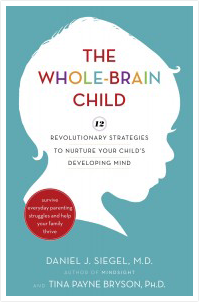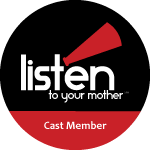L ast night I attend a presentation by Dr. Tina Payne Bryson, author of The Whole-Brian Child, at St. Xavier University in our Chicago neighborhood, on the southwest side of the city. Dr. Bryson was brought here thanks to a number of local organizations, including my daughter’s preschool, but in large part due to the effort of Carly Carney, a local mom and owner of Beverly Yoga Center.
ast night I attend a presentation by Dr. Tina Payne Bryson, author of The Whole-Brian Child, at St. Xavier University in our Chicago neighborhood, on the southwest side of the city. Dr. Bryson was brought here thanks to a number of local organizations, including my daughter’s preschool, but in large part due to the effort of Carly Carney, a local mom and owner of Beverly Yoga Center.
I have always been a big note-taker, ever since my school days, and with the advent of smart phones I have learned how to type pretty darn fast with my thumbs in the Notes app on my iPhone. So last night, during Dr. Bryson’s presentation, I took a lot of notes and also tweeted (#wholebrainchild) some of my take-aways. You can follow Dr. Bryson on Twitter @tinabryson and like her Facebook page here.
First and foremost, I recommend you get a copy Dr. Bryson’s book, as I did last night, as it covers much of what she talked about in her presentation. But in the meantime, because so many local moms have asked for copies of my notes (when they got wind that I took them, because I emailed them to a few friends), here they are. There are a bit disjointed, as I didn’t try to organize them in any way, in part because I don’t have time today and this way you get a small window into the way my brain processes and records information.
Please let me know if you have any questions after reading this and I will gladly try to clarify, what I meant. I wasn’t able to get down everything Dr. Bryson shared with us, but I did capture a lot of her insights and recommendations. Of course these are not a replacement for reading Dr. Bryson’s book, which I can’t wait to dig into, along with so many other books on my reading list right now! I might as well swear off TV in the near future if I am ever gong to catch up.
~~~~~~~~~~~~~~~~~~~~~~~~~
The Whole-Brain Child Presentation at St. Xavier University by Dr. Tina Payne Bryson (Wednesday, April 10, 2013)
Check out –> Wendy Mogul “The Blessing of a Skinned Knee”
If you have been around children in any capacity today, you are likely carrying some stress with you.
Will cover strategies to survive the moment, but also give your child repeated opportunities to wire their brains to thrive.
Learning how the brain is wired can help us learn to parent.
Saying your just tired go to bed… doesn’t work.
What Shapes the Brain?
If you think your adolescent is losing their mind, neurologically you are correct!
What determines what gets cut or “pruned” and what stays.
Our genes and experience impact us about 50/50.
Parents are brain architects.
Left and Right Hemisphere
Left
-Logic
-Linear
-Linguistic
-Literal
Right
-Senses emotion
-Random
-Non-verbal
-Senses body
-Whole/context
Left = Emotional Dessert
Right = Emotional Tsunami
Left & Right hemisphere need to work together
75% of her phone calls from parents of 3rd & 4th graders
Anxiety peaks at this age 3/4 grade
The two brain hemispheres take turns with their growth spurts.
JP on the cupcakes
cakewrecks.com
Integration
=
flexible
adaptive
coherent
energized
stable
We know left & right hemisphere integration isn’t happening when there is chaos or rigidity.
Chaos, rigidity or both = some kind of mental illness
When your child is upset, logic and reason don’t work.
Strategy #1: Connect & Redirect
Connect with emotions before redirecting behavior.
R: nonverbal comfort–touch, tone of voice, facial expression, empathetic talk, pausing, etc.
L: solutions, words, planning, logical explanations, boundaries
Strategy #2: Name it to Tame it
Help kids tell their story. (collaborative story telling around an issue)
L: Explain, put things in order,
R:
Deep breaths help us to regulate in the moment.
When something is hard, it is important to teach our children to share what they are feeling to try to make sense of it. To share our stories…
Upstairs & Downstairs brain
PBS.org This Emotional Life series
An unfinished upstairs brain = primitive behavior sometimes
It’s not fully developed until our 20’s.
the brain in the palm of your hand
My downstairs brain made me do it.
Lose the upstairs abilities…
SHE IS NOT A FAN OF TIME OUT!!!
She thinks it not effective… Find her article!
“Hands are for loving and for helping.”
We are going to have ruptures all of the time. But when it happens, we have to repair.
Won’t vs. Can’t
Children usually behave when the can vs. when they want to.
“Chase the why…” Try to figure out why they are behaving the way the are.
This doesn’t mean we excuse our children’s behavior, but why and how the behavior is happening matters.
Our capacity to handle situations fluctuates with our circumstances, both adults & kids.
How do we expand their capacity?
Build the staircase…
Strategy #2: Engage, Don’t Enrage
In moments of discipline or difficulty, which part of the brain do you want to activate?
What happens when you trigger the downstairs brain?
What happens she you appeal to the upstairs brain?
Treat your kid like a dog when they are upset… You wouldn’t yell at a dog to behave, you would try to calm it down and then help it learn.
The point of discipline is to teach, not to give a consequence.
Get to your child’s eye level to communicate and help them understand you better.
Discipline = Teaching
–especially emphasizing insight and empathy…
Don’t fix and rescue all the time
— instead, ask “What’s your plan for…”
Struggle = Opportunity
for integrating the brain for building the staircase
Each moment kids are having a hard time, they are communicating that they need to build something in their brain.
Even the times we mess up can be valuable. As long as we repair…
There’s nothing more important you can do than to be intentional with parenting.
What we do matters profoundly.
We often parent our first born with “fear based” parenting.
They hold it together all day at school, which is why they fall apart with us.
It’s a Boy by Michael Cain?
Dinner Games
The brain pays attention to novelty
Daniel Pink books
Building relationships and reflection builds our frontal lobe to be successful, but that isn’t happening enough in schools.
Unstructured play builds our frontal lobes.
Having secure attachment with at least one person/adult is key to development and success.
How Children Succeed by Paul Tufts?
How do we peacefully resolve conflict?
Goldie Hawn “Mind Up”
Tools of the Mind
The Responsive Classroom
Roots of Empathy book
Nurture Shock
Ted Talk re: the study about how movement effects emotional states
“Show me an animal and I will guess what it is…”
Mirror Neurons = Discovered in Parma Italy in the early 1990’s…
Spectrum Disorders (autism), kids on the spectrum, their mirror neurons don’t function the same… Their regulatory system is different.
What to Do if You Worry Too Much workbook
Emphasis on how movement helps us to self-regulate our emotions.
Susan Greenland “Glitter Ball” video on You Tube (get them at Target)
author of The Mindful Child
Have children put their hands on their chest at the end of the day and together take some deep breaths, encourage them to let go of what happened today and help them learn to self regulate that way.
If we do this regularly it will help them learn to do it in other situations.
Show them how to move a stuffed animal on their belly slowly…
Emphasize boundaries with warmth and comfort…
Upstairs tantrums (manipulative), need to be managed differently than downstairs (which require more connection and discussion of feelings).
Emotions start in the body…
#1 technique to cope is to get your body in a relaxed state.
Movement, laughter and crying all release tension.
Family meetings…
Are great! Allow your children to voice their opinions.
How to handle food?
Favorite trick… The more you care, the more they fight. Same for potty training.
Muffin tin trick, fill with healthy food in bite size portions and set it out to nibble on
How to deal with anger?
It’s okay to be mad is sooooo important! Teach our children that feeling nervous and disappointment is NORMAL!
kidsinhouse.com –>
8,000 videos from experts on so many topics
The Conscious Parent author –> teach our children to sit in the muck of our ordinariness. It is how we learn empathy.
Our goal is to walk with our child through a tantrum, not to stop it.
Time outs can be effective for a while, then they become less effective.
Instead of time outs, address the feeling behind the behavior and address the behavior itself. You can also offer an alternative. Then move on as quickly as possible.
On her website, article on 10 Most Common Discipline Mistakes.











{ 2 comments… read them below or add one }
Thanks for the book tip and the notes, Kathy. It sounds like a fascinating presentation!
Lori Lavender Luz recently posted..Q&A: Quest to raise awareness about adoptee rights
Really informative sharing . I was search a presentation about this book. this would be helpful